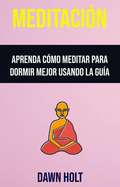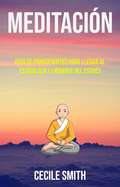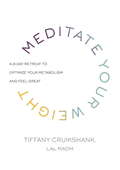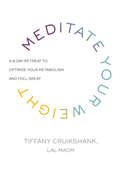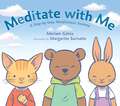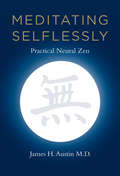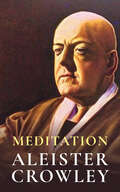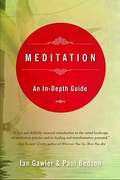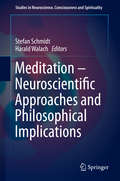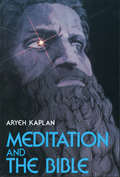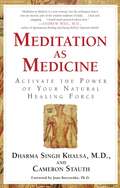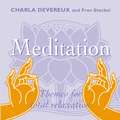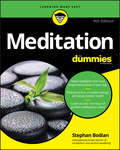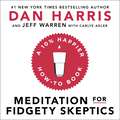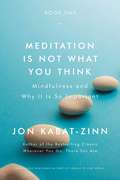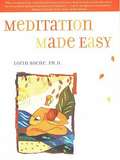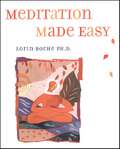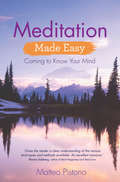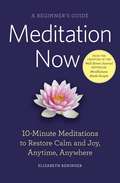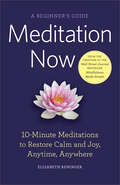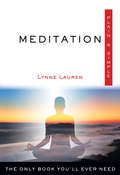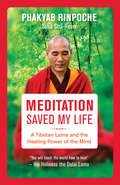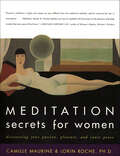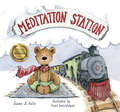- Table View
- List View
Meditación: Utiliza esta guía para mejorar tu sueño con tu práctica.
by Dawn HoltDebido a los mitos que se pueden escuchar o a la falta de una guía apropiada, muchas personas no confían en la meditación. El propósito de este libro es cambiar esto. Hecho específicamente para principiantes, es una guía completa que te ayudará a entender las bases de la meditación y te mostrará una gran variedad de actividades y estrategias para incorporar esta práctica a tu vida. La fuerza conocida como kundalini ha formado parte de la práctica de la meditación por incontables generaciones alrededor del mundo, y ahora está tomando mucha popularidad en occidente. La kundalini es una fuerza principal de las religiones Dharma y está centrada cerca de la base de la espina dorsal. Existen muchas tradiciones que utilizan la kundalini para muchos propósitos, desde la búsqueda de una guía para solucionar un problema hasta para lidiar con una indigestión, pero sobre todo para empezar un periodo de iluminación espiritual. Se dice que la kundalini siempre está presente, esperando a ser liberada. No esperes más y descubre LA CLAVE para tener una nueva y mejor vida.
Meditación: Vida de Plena Consciencia
by Cecile SmithEste libro contiene pasos y estrategias comprobados sobre cómo ayudarlo a enfrentar el ritmo abrumador de la vida moderna. Solo necesita practicar unos pocos minutos al día; no cuesta nada y puede producir beneficios tangibles para su equilibrio emocional. En ocasiones todos buscan esta relajación interna profunda o se encuentran a sí mismos simplemente un poco demasiado estresados. De la misma manera, mucha gente sufre de ansiedad – el trabajo, las finanzas, la salud, la familia, la situación social y muchas otras cosas. En pocas palabras este libro es la más completa, práctica y moderna guía que una persona puede leer hoy sobre la meditación. Contiene todos los pasos necesarios bellamente combinados con muchas fotos e ilustraciones para iniciarlo en el maravilloso mundo de la meditación. Como se enterará leyendo este libro, a través de la práctica de la meditación podrá disminuir sus niveles de estrés, perder peso, estar en mejor forma física y mejorar el nivel general de sus condiciones de vida. Este libro proporcionará una gran cantidad de detalles sobre qué es la meditación, por qué es importante practicarla, cómo convertirse en un practicante de la meditación, en qué aspectos de su vida va a ver una gran mejora y cómo mantenerse en el buen camino para poder alcanzar sus metas lo más pronto posible.
Meditate Your Weight: A 21-Day Retreat to Optimize Your Metabolism and Feel Great
by Tiffany CruikshankTHE MIND MAKEOVER THAT MAKES OVER YOUR METABOLISMHundreds of medical studies have shown the spectacular health benefits of meditation. Now Tiffany Cruikshank, founder of Yoga Medicine, puts that scientific research to good, practical use by incorporating easy-to-use, targeted meditations into a unique weight-loss program. This 21-day plan optimizes health as well as body image by tapping the hidden strength of the mind. We learn a whole new way to lose weight; and it takes just a few relaxing and energizing minutes a day. Learn:* How to get started: advice for new meditators (no weird positions or chants required) * 3, 5, 7, and 10 minute meditations that bust cravings, break self-defeating habits, stress-proof the body, and reboot the brain * What to eat--and the top 5 foods to consider avoiding* How to continue your success after your 21-day retreat * Bonus: 10 stress-relieving, cardio-revving yoga exercises to complement the plan Each day of the plan in Meditate Your Weight helps you explore and release what's weighing you down physically, emotionally, and mentally--the mental blocks, thoughts, habits, and behaviors that stand in your way--to make it easier to think more clearly, make better choices, and maximize metabolism. As you lighten up on the inside, you'll lighten up on the outside. Less stress=less belly fat. More calm + more balance = a healthier you.From the Hardcover edition.
Meditate Your Weight: A 21-Day Retreat to Optimize Your Metabolism and Feel Great
by Tiffany CruikshankHundreds of medical studies have shown the spectacular health benefits of meditation. Now Tiffany Cruikshank, founder of Yoga Medicine, puts that scientific research to good, practical use by incorporating easy-to-use, targeted meditations into a unique weight-loss programme. This 21-day plan optimizes health as well as body image by tapping the hidden strength of the mind. We learn a whole new way to lose weight and it takes just a few relaxing and energizing minutes a day. Learn:• How to get started: advice for new meditators (no weird positions or chants required)• 3, 5, 7 and 10 minute meditations that bust cravings, break self-defeating habits, stress-proof the body and reboot the brain• What to eat - and the top 5 foods to consider avoiding• How to continue your success after your 21-day retreat• Bonus: 10 stress-relieving, cardio-revving yoga exercises to complement the planEach day of the plan in Meditate Your Weight helps you explore and release what's weighing you down physically, emotionally and mentally – the mental blocks, thoughts, habits and behaviours that stand in your way – to make it easier to think more clearly, make better choices and maximize metabolism. As you lighten up on the inside, you'll lighten up on the outside!
Meditate with Me: A Step-By-Step Mindfulness Journey
by Mariam GatesThis accessible and fun guide to meditation and mindfulness is the perfect introduction for young children Meditation does a body good, and can even help kids as young as four or five. This practical guide is gentle, clear, and a pleasure to use. Kids will learn how to focus on their breath, on the sensations in their body, and on the sounds around them to help them relax, settle their busy minds, and understand their emotions. Illustrated with cheerful drawings of five animal friends, the book offers step-by-step directions and a repeating refrain: "Breathe in, and fill your whole body. Breathe out, and relax your whole body." It's an invigorating first experience of mindfulness that can be shared by parents and children at home, or by teachers and students in the classroom.
Meditating Selflessly: Practical Neural Zen
by James H. AustinA guide to Zen meditative practice informed by the latest findings in brain research. This is not the usual kind of self-help book. Indeed, its major premise heeds a Zen master's advice to be less self-centered. Yes, it is "one more book of words about Zen," as the author concedes, yet this book explains meditative practices from the perspective of a "neural Zen." The latest findings in brain research inform its suggestions. In Meditating Selflessly, James Austin—Zen practitioner, neurologist, and author of three acclaimed books on Zen and neuroscience—guides readers toward that open awareness already awaiting them on the cushion and in the natural world. Austin offers concrete advice—often in a simplified question-and-answer format—about different ways to meditate. He clarifies both the concentrative and receptive styles of meditation. Drawing widely from the exciting new field of contemplative neuroscience, Austin helps resolve an ancient paradox: why both insight wisdom and selflessness arise simultaneously during enlightened states of consciousness.
Meditation
by Alesiter CrowleyOriginally published as part of his magnum opus Liber ABA, Meditation explains Crowley's system of meditation, designed to still and mind and enable the single-pointed concentration so essential to his occult teachings. Crowley explains important concepts like Asana, Pranayama, Yama, Niyama, Pratyahara, Dharana and Samadhi, borrowing heavily from Indian yogis.
Meditation
by Ian Gawler Paul BedsonPowerful medical research tells us that meditation reliably prevents illness, maximises performance, is a profound healing technique and leads to peace of mind. It restores our natural state of balance and once this is achieved there is a flow-on effect. Soon we experience physical balance and good health, emotional balance and poise, mental clarity and confidence and spiritual harmony. Easy to learn, reliable in their benefits, the techniques presented here will help you to relax effortlessly and meditate profoundly.
Meditation
by Linda Wasmer AndrewsHave you ever tried to focus on a particular task, only to find your thoughts racing and your mind wandering? In fact, most people have trouble concentrating on one thing at a time, which creates stress and affects our daily activities. One solution to this problem is meditation, or the practice of intense concentration. The ability to meditate can be applied to almost anything in life, from playing sports to painting pictures. Find out how meditation can help you to be stressed less and enjoy life more. Step-by-step instructions for breathing and meditation exercises are included.
Meditation - Neuroscientific Approaches and Philosophical Implications
by Harald Walach Stefan SchmidtThis volume features a collection of essays on consciousness, which has become one of the hot topics at the crossroads between neuroscience, philosophy, and religious studies. Is consciousness something the brain produces? How can we study it? Is there just one type of consciousness or are there different states that can be discriminated? Are so called "higher states of consciousness" that some people report during meditation pointing towards a new understanding of consciousness? Meditation research is a new discipline that shows new inroads into the study of consciousness. If a meditative practice changes brain structure itself this is direct proof of the causal influence of consciousness onto its substrate. If different states of consciousness can be linked with properties and states of the brain this can be used to study consciousness more directly. If the sense of self is modifiable through meditative techniques and this can be objectively shown through neuro-imaging, this has profound implications for our understanding of who we are. Can consciousness, in deep states of meditative absorption, actually access some aspect of reality which we normally don't? Meditation research can potentially foster us with a new access to the phenomenological method in general. This has even been branded with a new catch-phrase: Contemplative Science. It brings together the most modern neuroscientific approach and the most advanced phenomenological methodology of studying the mind from within, through highly skilled self-observation that has gone through many thousand hours of honing the capacity to look carefully, without distraction. This book addresses these issues by bringing together some of the leading researchers and thinkers in the field. The scope of the volume reaches from first person neuroscience to Indian philosophy, from pedagogic applications to epistemological aspects and from compassion meditation to the study of brain activity.
Meditation And The Bible
by Aryeh KaplanA highly radical interpretation of the Bible demonstrating the methods of meditation used by the Prophets to attain their unique states of consciousness. First English translation from ancient unpublished manuscripts, with commentary.
Meditation As Medicine: Activate the Power of Your Natural Healing Force
by Joan Borysenko Cameron Stauth Khalsa Dharma SinghProven effective by scientific research and presented here by Dr. Dharma Singh Khalsa and Cameron Stauth, the practice of Medical Meditation revolutionizes the healing process. By balancing and regenerating the body's ethereal and physical energies through simple meditations, Medical Meditation unites the mind, body, and spirit into a powerful triad. Each Medical Meditation here has a specific physiological effect, targeting afflictions from arthritis to ulcers to cancer. Dr. Khalsa details the five unique attributes that endow this type of meditation with far more power than standard meditation. The combination of special postures and movements; exact positioning of the hands and fingers; particular mantras; specific breathing patterns; and a unique focus of concentration can change your entire biochemical profile, easing you into a calm, healing state. Practiced in conjunction with conventional or alternative medical treatments, cutting-edge Medical Meditation activates the healing force within you.
Meditation Book: Themes for Total Relaxation (Book-in-a-box Ser.)
by Fran Stockel Charla DevereuxBased on the best-selling Book-in-a-Box kits, The Meditation Book will help you to enter a tranquil state and feel completely calm and composed. It tells you all you need to know to make meditation a part of your daily life.
Meditation For Dummies
by Stephan BodianTake an inward journey for a happier, healthier life Meditation has been used for centuries to reduce stress, increase energy, and enhance overall health and well-being--so it's no wonder more and more people in today's fast-paced and stress-centric world are adopting this age-old practice. If you want to achieve a greater state of calmness, physical relaxation, and psychological balance, Meditation For Dummies is your life raft. Covering the latest research on the health benefits of meditation, this new edition explains in plain English how you can put meditation into practice today and start reaping the benefits of living a more mindful life. Whether you're new to meditation or a seasoned practitioner coming back for a refresher course, this plain-English guide provides a wealth of tips and techniques for sitting (or lying) down with your mind to meditate successfully. From preparing your body for meditation to focusing your awareness and being open to the present moment, it covers everything you need to put distractions to rest and open yourself up to a meditation practice that works for you. Provides the latest research on the causes of happiness and how meditation can improve your mood Includes a new chapter on the growing trend of meditation in the workplace Explains how meditation and other mindfulness practices have made their way into hospitals, schools, prison, and military groups Illustrates the benefits of taking time to consciously cultivate mindfulness through meditation If you're ready to find some zen and benefit from all meditation has to offer, this friendly guide sets you up for success.
Meditation For Fidgety Skeptics: A 10% Happier How-To Book
by Dan HarrisABC News anchor Dan Harris used to think that meditation was for people who collect crystals, play the pan pipes, and use the word namaste without irony. After he had a panic attack on live television, he went on a strange journey that ultimately led him to become one of meditation's most vocal public proponents. <p><p>Science suggests that meditation can lower blood pressure, mitigate depression and anxiety, and literally rewire key parts of the brain, among numerous other benefits. And yet there are millions of people who want to meditate but aren't actually practising. What's holding them back? <p><p>In this guide to mindfulness and meditation for beginners and experienced meditators alike, Harris and his friend Jeff Warren, embark on a cross-country quest to tackle the myths, misconceptions, and self-deceptions that stop people from meditating. They rent a rock-star tour bus and travel across the US, talking to scores of would-be meditators, including parents, police officers, and even a few celebrities. They create a taxonomy of the most common issues ("I suck at this," "I don't have the time," etc.) and offer up science-based life hacks to help people overcome them. <p><p>The book is filled with game-changing and deeply practical meditation instructions. Amid it all unspools the strange and hilarious story of what happens when a congenitally sarcastic, type-A journalist and a groovy Canadian mystic embark on an epic road trip into America's neurotic underbelly, as well as their own.
Meditation Is Not What You Think: Mindfulness and Why It Is So Important
by Jon Kabat-ZinnWe think we know what meditation is--especially in an era when "mindfulness" has improbably rocketed into the mainstream. Millions of people around the world have taken up a formal mindfulness meditation practice as part of their everyday lives. But there's no hard-and-fast rule that says you have to meditate in a certain way, in a particular place, or following a specific tradition. So what is meditation anyway? And why might it be worth trying? Or nurturing further if you already have practice? Meditation Is Not What You Think was originally published in 2005 as part of a larger book entitled Coming to Our Senses: Healing Ourselves and the World Through Mindfulness. Updated with a new foreword by the author, these questions (and their answers) are particularly relevant for the current era . If you're curious as to why meditation is not for the "faint-hearted," how taking some time each day to drop into awareness can actually be a radical act of love, and why paying attention is so supremely important, read on for a master class from one of the pioneers of mindfulness in the mainstream world.
Meditation Made Easy
by Camille Maurine Lorin RocheTips on how to make meditation simple and pleasurable. Provides info on creating mini meditations, overcoming boredom and racing thoughts, customizing personal practices, and more.
Meditation Made Easy
by Lorin RocheYou′ve probably heard about the benefits of meditation: Sharper thinking, reduced stress, improved concentration, lower blood pressure, even increased sexual pleasure , all of these positive effects have been confirmed by science. In this uniquely accessible guide, Lorin Roche shows that meditation is that easy , and pleasurable. Roche answers questions and debunks meditation myths, and gives three easy-to-follow techniques for getting started 塴he Do Nothing Technique," "Salute Each of the Senses," and "Feeling at Home Exercise". He and shows you how to integrate "mini meditations" into spare moments of the day, from savouring morning coffee to taking advantage of the five minutes before a meeting. He explains how to overcome meditation obstacles, customise meditation to your own needs, and use your breath, voice, and attention as meditation aids. And he shows how meditation will give you the power to explore your inner passions , and enrich your sense of self.
Meditation Made Easy: Coming to Know Your Mind
by Matteo PistonoAn introductory step-by-step guide to meditation, suitable for beginners as well as those wishing to refresh their knowledge and practice.Meditation Made Easy is a clear, how-to book on meditation aimed at complete beginners and practicing readers looking for easy, approachable meditation techniques. In this book, readers will learn: How to develop a consistent meditation practice at home and while traveling Basic instructions and techniques of meditation Instructions for seated, walking, and supine meditation postures How to use the breath as an object of meditation How to deal with distraction and lethargy in meditationThis book is for readers who do not know how to start a practice, or for those people who do not have access to teachers. It is especially useful for the multitudes of yoga practitioners who want to meditate but have never received solid instruction in the yoga studio. Using traditional Eastern practices, but aimed at a Western audience, the methods in this book can be utilized on the meditation cushion as well as in daily life when stress and challenges arise. Previously published in the Hay House Basics series.
Meditation Now: A Beginner's Guide
by Elizabeth ReningerFrom the creators of the Wall Street Journal bestseller Mindfulness Made Simple comes a new book to help busy meditators release tension, relieve stress, and reconnect with peace and tranquility. Meditation Now: A Beginner's Guide provides friendly advice, step-by-step guidance, and a range of ten-minute meditations that fit easily into tight schedules. <p><p> Filled with time-honored practices and insightful discussions, Meditation Now: A Beginner's Guide makes it easy to learn meditation, with: *Step-by-step instructions for 18 meditation techniques that can be practiced anytime, anywhere *14 "Take Ten" meditations to promote mindfulness in everyday situations like traffic jams and work presentations *Essential advice and guidelines for overcoming common obstacles like boredom and relating skillfully to thoughts and emotions *3 focused 28-day meditation plans for those months when you need extra emotional support, happiness, or relaxation *Inspirational quotations and practical tips that motivate you to deepen your practice <p> With Meditation Now: A Beginner's Guide, peace, clarity, and wisdom can be yours with just ten minutes of restful breathing a day.
Meditation Now: A Beginner's Guide: 10-Minute Meditations to Restore Calm and Joy, Anytime, Anywhere
by Elizabeth ReningerTen minutes to a calmer, more peaceful you From the creators of the Wall Street Journal bestseller Mindfulness Made Simple comes a new book to help busy meditators release tension, relieve stress, and reconnect with peace and tranquility.Meditation Now: A Beginner's Guide provides friendly advice, step-by-step guidance, and a range of ten-minute meditations that fit easily into tight schedules. Filled with time-honored practices and insightful discussions, Meditation Now: A Beginner's Guide makes it easy to learn meditation, with: Step-by-step instructions for 18 meditation techniques that can be practiced anytime, anywhere 14 "Take Ten" meditations to promote mindfulness in everyday situations like traffic jams and work presentations Essential advice and guidelines for overcoming common obstacles like boredom and relating skillfully to thoughts and emotions 3 focused 28-day meditation plans for those months when you need extra emotional support, happiness, or relaxation Inspirational quotations and practical tips that motivate you to deepen your practice With Meditation Now: A Beginner's Guide, peace, clarity, and wisdom can be yours with just ten minutes of restful breathing a day.
Meditation Plain & Simple: The Only Book You'll Ever Need (Plain & Simple Series)
by Lynne LaurenMeditation is a practice that calms the mind and the body in a natural way. Its aim is to quiet or still the mind, which leads to calm awareness without the interference of troublesome thoughts. Meditation can help you focus, relax, and cope with life's twists and turns.Meditation, Plain & Simple is a wise and helpful primer to the practice of meditation. Lynne Lauren not only explains why it is important to meditate, but also demonstrates how simple meditation is for the average person. It can be done anywhere by anyone, and you don&’t have to sit on the floor or stand on your head. In addition, she provides a brief overview of the different types of meditation along with more than 50 meditations and visualizations that can be used in different circumstances to reach particular goals.This book is a lovely introduction for anyone who wishes to slow down, de-stress, and discover how rich life can be!
Meditation Saved My Life: A Tibetan Lama and the Healing Power of the Mind
by Phakyab RinpocheIn 2003, Tibetan lama Phakyab Rinpoche was admitted to the emergency clinic of the Program for Survivors of Torture at Manhattan’s Bellevue Hospital. After a dramatic escape from imprisonment in China, at the hands of authorities bent on uprooting Tibet’s traditional religion and culture, his ordeal had left him with life-threatening injuries, including gangrene of the right ankle. American doctors gave Rinpoche a shocking choice: accept leg amputation or risk a slow, painful death. An inner voice, however, prompted him to try an unconventional cure: meditation. He began an intensive spiritual routine that included thousands of hours of meditation over three years in a small Brooklyn studio. Against all scientific logic, his injuries gradually healed. In this vivid, passionate account, Sofia Stril-Rever relates the extraordinary experiences of Phakyab Rinpoche, who reveals the secret of the great healing powers that lie dormant within each of us.
Meditation Secrets for Women: Discovering Your Passion, Pleasure, and Inner Peace
by Camille Maurine Lorin RocheAn “excellent, empowering” guide to meditation, catering to the particular needs of women (Publishers Weekly).“Wise, wonderful, and revolutionary.” —Sylvia Brinton Perera, author of Descent to the Goddess“Applause goes to the authors of this provocative book for bringing the art of embodied meditation into the twenty-first century. At last!” —Emilie Conrad, founder of ContinuumFinally—an approach to meditation especially for women!The benefits of meditations are manifold—but so few practices are tailored to the special needs and interests of women. Now, with Meditation Secrets for Women, you can discover how to love your body and find a time and place to tune into yourself and restore inner balance. Get in touch with your body’s natural rhythms. Honor your instincts, and tap into your feminine power so that you can emerge nourished, revitalized, and joyful. Meditation Secrets for Women offers all the tools and insights necessary for women to design their own custom meditation techniques, without all the restrictions of traditional practices.Learn how to:Make use of sensual, pleasurable meditation techniquesGain a refreshing, rejuvenating rest that is deeper than sleepRelieve stress and promote good healthRelax and be yourself as you reap life-affirming benefitsLive in harmony with your worldEnhance your relationships and creativity“Women’s meditation insights and needs are very different from the traditional methods used for centuries by men in monasteries. . . . Meditation Secrets for Women teaches you how to meditate with full access to the emotions and body wisdom that are part of the Divine.” —Christine Northrup, MD, author of Women’s Bodies, Women’s Wisdom“A sensible meditation guide that honors and enhances our natural way of being. Bound to be sacrilege in some circles, the information herein is a welcome change from the anti-matter nihilism of many spiritual systems.” —Anodea Judith, PhD, author of Eastern Body, Western Mind and Wheels of Life
Meditation Station
by Susan B. KatzWinner of the 2020 International Children's Mind/Body/Spirit Book Award!Your racing train of thoughts may try to take you down the railroad tracks, but you can stay in the Meditation Station, where children ages 4-8 learn how to calm their bodies and minds.All aboard for Meditation Station! It's time to learn how to manage our busy minds, difficult feelings, and frustrations by staying with our breath and in our body. Your train of thoughts might be racing, but you can manage it with some simple steps. Take a deep breath in, and then let the breath out slowly. That is how you will learn what meditation is all about. The next train is coming. Can you hear it chugging along? Stay in the meditation station--don't hop on the train! Just wave goodbye to your racing mind and find inner calm.
